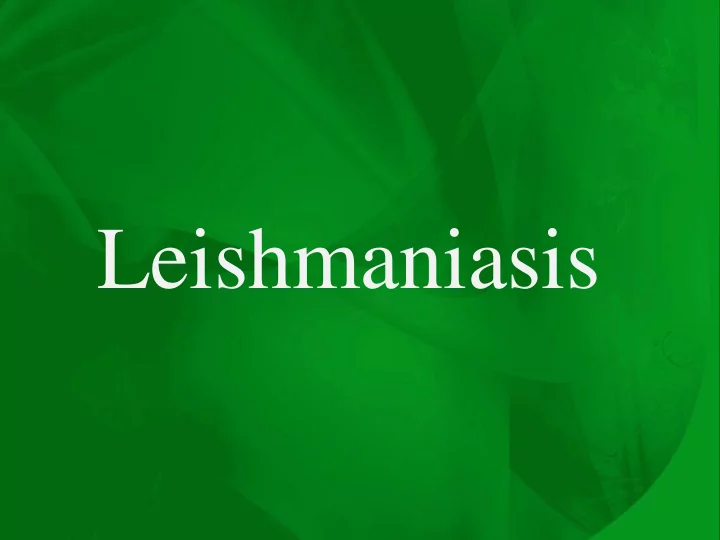

Leishmaniasis
Promastigotes of Leishmania Amastigote of Leishmania
The life cycle of Leishmania
Leishmania Parasites and Diseases SPECIES Disease Leishmania tropica* Cutaneous leishmaniasis Leishmania major* Leishmania aethiopica Leishmania mexicana Leishmania braziliensis Mucocutaneous leishmaniasis Leishmania donovani* Visceral leishmaniasis Leishmania infantum* Leishmania chagasi * Endemic in Saudi Arabia
World distribution of Visceral Leishmaniasis
Sand fly
Amastigotes of Leishmania
Promastigotes of Leishmania
lesion
lesion
Clinical types of cutaneous leishmaniasis • Leishmania major : Zoonotic cutaneous leishmaniasis: wet lesions with severe reaction • Leishmania tropica : Anthroponotic cutaneous leishmaniasis: Dry lesions with minimal ulceration Oriental sore (most common) classical self- limited ulcer
Uncommon types • Diffuse cutaneous leishmaniasis (DCL): Caused by L. aethiopica , diffuse nodular non- ulcerating lesions. Low immunity to Leishmania antigens, numerous parasites. • Leishmaniasis recidiva ( lupoid leishmaniasis): Severe immunological reaction to leishmania antigen leading to persistent dry skin lesions, few parasites.
Diffuse cutaneous leishmaniasis Leishmaniasis recidiva
cutaneous leishmaniasis Diagnosis : • Smear: Giemsa stain – microscopy for LD bodies (amastigotes) • Biopsy: microscopy for LD bodies or culture in NNN medium for promastigotes
NNN medium
Pentostam ( sodium stibogluconate) for treatment of all types of leishmaniasis
Visceral leishmaniasis • There are geographical variations. • The diseases is called kala-azar • Leishmania infantum mainly affect children • Leishmania donovani mainly affects adults
Presentation • Fever • Splenomegaly, hepatomegaly, hepatosplenomegaly • Weight loss • Anaemia • Epistaxis • Cough • Diarrhoea
Untreated disease can be fatal After recovery it might produce a condition called post kala-azar dermal leishmaniasis (PKDL)
Fever 2 times a day due to kala-azar
Hepatosplenomegaly in visceral leishmaniasis
Mucocutaneous leishmaniasis
Visceral leishmaniasis Diagnosis (1) Parasitological diagnosis: Bone marrow aspirate 1. microscopy Splenic aspirate 2. culture in NNN medium Lymph node Tissue biopsy
Bone marrow aspiration Bone marrow amastigotes
(2) Immunological Diagnosis: • Specific serologic tests: Direct Agglutination Test (DAT), ELISA, IFAT • rK39 antigen-based immunochromatographic tes . TWO LIMITATIONS FOR SEROLOGIC TESTS: – Do not diagnose relapses. – In endemic areas it is sometimes +ve in healthy individuals.
DAT test ELISA test
Antileishmanial drugs 1. Pentavalent antimonials meglumine antimoniate ,sodium stibogluconate:IM IV ,can be administered Intralesionally for the treatment of cutaneous leishmaniasis.Cardiotoxicity and sudden death are serious but uncommon side-effects. 2. Amphotericin B deoxycholate Amphotericin B is a polyene antibiotic, should always be given in hospital to allow continuous monitoring of patients. 3. Lipid formulations of amphotericin B Several formulations, they are similar to amphotericin B deoxycholate in their efficacy but are significantly less toxic. 4. Paromomycin Paromomycin (aminosidine) is an aminoglycoside antibiotic, usually IM. A topical formulation is available for cutaneousleishmaniasis. 5. Pentamidine isethionate IM or IV.Severe adverse effects — diabetes mellitus, severe hypoglycaemia, shock, myocarditis and renal toxicity — limit its use. 6. Miltefosine This alkyl phospholipid (hexadecylphosphocholine) was originally Miltefosine is potentially teratogenic and should not be used by pregnant women 7. Azoles medicines: ketoconazole, fluconazole, itraconazole These oral antifungal agents have variable efficacy in leishmaniasis treatment
Treatment Of Cutaneous Leishmaniasis • No treatment – self-healing lesions • Medical: o Pentavalent antimony (Pentostam), Amphotericin B o Antifungal drugs o +/- Antibiotics for secondary bacterial infection. • Surgical: o Cryosurgery o Excision o Curettage REFERENCE :WHO (2010) Control of leishmaniasis. Report of a meeting 571 of the WHO expert committee on the control of leishmaniasis. http://whqlibdoc.who.int/trs/WHO_TRS_949_eng.pdf
Treatment of visceral leishmanisis • Recommended treatment varies in different endemic areas: – Pentavalent antimony- sodium stibogluconate (Pentostam) – Amphotericin B Treatment of complications: • Anaemia • Bleeding • Infections etc. REFERENCE :WHO (2010) Control of leishmaniasis. Report of a meeting 571 of the WHO expert committee on the control of leishmaniasis. http://whqlibdoc.who.int/trs/WHO_TRS_949_eng.pdf
Recommend
More recommend